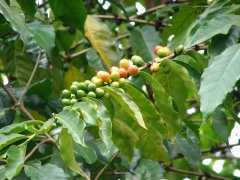The principle of Italian espresso extraction: on the effect of coffee powder on concentrated extraction

For professional baristas, please follow the coffee workshop (Wechat official account cafe_style)
The concentrated extraction flow is completely different from the boiling extraction flow, because the concentrated extraction is carried out by pressure and resistance. The pressurized extraction water touches the upper end of the powder bowl, and the flow of water through the solid coffee pressed powder creates resistance, thus creating pressure throughout the coffee pressed powder field.
An important factor in this resistance is the particle size distribution (grind distribution) of coffee powder. The particle size distribution of coffee powder makes the resistance layer of coffee pressed powder, and various coffee ingredients can be extracted by pressure.
These coffee powders are made up of particles of different sizes to produce extraction resistance. The one who has made the greatest contribution to this process is Fine.
Micropowder refers to very small coffee particles, usually less than 100 centimeters (microns).
| | Conceptual map of coffee pressed powder structure according to particle size |
These fine particles were once seen as limiting the extraction speed between thicker particles and helping to make a more stable extraction flow.
However, recent studies have pointed out that the fine powder not only affects the flow rate, but also has a direct effect on the whole extraction. Because micro-powder accounts for a large proportion of the extracted coffee powder.
Generally speaking, 70% of the coffee powder is 80% of the so-called micro powder.
The following chart shows the particle size distribution (volume) and surface area benchmark particle size distribution of tapered blades (ROBUR) and flat blades (ANFIM SUPER CAIMANO).
The above data should let us seriously consider the effect of particles on extraction.
In summary, coffee particles make a stable flow and extraction, while producing a surface area that is effective for extraction.
Before we just talk about the uniformity of particles, we need to understand the kinetics and principle of coffee extraction.
Important Notice :
前街咖啡 FrontStreet Coffee has moved to new addredd:
FrontStreet Coffee Address: 315,Donghua East Road,GuangZhou
Tel:020 38364473
- Prev

Coffee to lose weight easily is how to do it, want to drink coffee to lose weight people must have self-control!
Coffee to lose weight easily is how to do it, want to drink coffee to lose weight people must have self-control! Coffee itself is not high in calories, and black coffee does have weight loss functions. But if you're used to adding sugar and milk to coffee, or even fancy cream and wine, calories aren't that simple! For example, the calories in a cup of mocha = a bowl of rice? so if
- Next

Why does Italian Coffee Bean extract Powder compare Italian Coffee with Coffee Bean blending
Professional barista communication please pay attention to the coffee workshop (Wechat official account cafe_style) espresso will be mixed beans, in order to increase the richness and harmony of the taste, but not absolutely necessary, but espresso is extracted with hot water and pressure, if it is not stirred to drink directly, the water-soluble and fat-soluble ingredients will be separated, the taste is not good
Related
- Beginners will see the "Coffee pull flower" guide!
- What is the difference between ice blog purified milk and ordinary milk coffee?
- Why is the Philippines the largest producer of crops in Liberia?
- For coffee extraction, should the fine powder be retained?
- How does extracted espresso fill pressed powder? How much strength does it take to press the powder?
- How to make jasmine cold extract coffee? Is the jasmine + latte good?
- Will this little toy really make the coffee taste better? How does Lily Drip affect coffee extraction?
- Will the action of slapping the filter cup also affect coffee extraction?
- What's the difference between powder-to-water ratio and powder-to-liquid ratio?
- What is the Ethiopian local species? What does it have to do with Heirloom native species?

